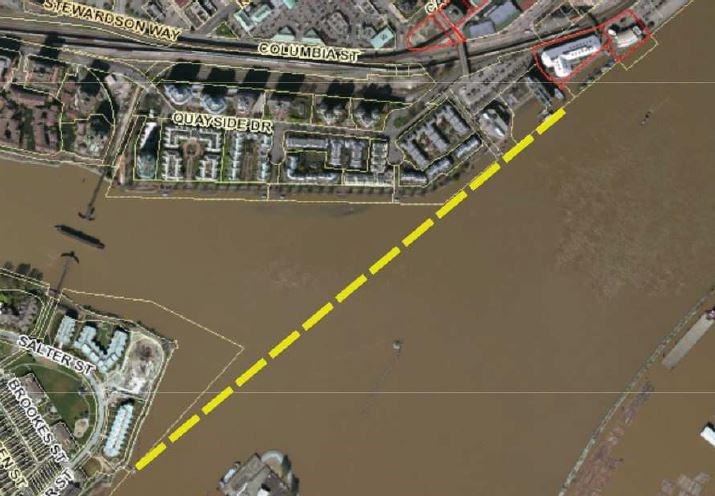High construction costs may have sunk the proposed Q2Q crossing – at least for now.
SNC Lavalin, which has reviewed the plan on the city’s behalf, estimates a pedestrian/cyclist crossing from Queensborough to the Quay would cost $39.1 million, which includes a 15 per cent design contingency and 10 per cent construction contingency. A staff report considered by council Monday states that’s “significantly higher” than the city previously estimated and is considered to be “well above” the resources available.
Coun. Patrick Johnstone said he’s a supporter of building a fixed connection between Queensborough and the mainland for pedestrians and cyclists, but it’s “just not doable” at that price for a city the size of New Westminster.
“I know we had $11 million set aside, specifically earmarked for this. I think if you came back with numbers in the $20-million range, I think council would have figured out ways to fill the gap and make that happen,” he said. “I think that was a tough decision we would have had to make, but we could have made that happen – but $40 million is a number that I think caught all of us by surprise. It puts us in a very difficult situation as far as moving forward right away on this project.”
Johnstone said he hasn’t given up on the concept of building a fixed connection between Queensborough and the Quay.
“We have to keep the dream alive,” he said. “In the meantime, we need to be practical about what we can actually get done. I think the ferry idea is suboptimal. I don’t think it’s the ideal solution. I am concerned about the accessibility of it. I am concerned about the long-term viability. I am concerned about the message of essentially a very ephemeral system. It’s the difference between building a light rail line and a bus route. A light rail line, when you build the infrastructure, it’s there. When you build a bus route you can change bus schedules any time you want.”
Coun. Chuck Puchmayr said the city knew the $11 million wouldn’t be enough, but was surprised at the cost. He’s disappointed that Southern Rail has said there’s no way to provide a connection as part of the train bridge between the Quay and Queensborough and would like the city to continue to pursue that discussion further.
“Let’s not say goodbye to this,” he said, “but certainly building a fixed link with all the other projects we are doing, I believe it’s out of the question.”
As part of the city’s decision to allow a destination casino in New Westminster, it negotiated “development assistance compensation” funds for a variety of projects in the downtown and Queensborough neighbourhoods, including a crossing between the two areas.
“While the city has been successful in obtaining modest TransLink grants in 2015 and 2016 for Q2Q as well as a small donation from a private developer, totalling approximately $500,000, less than one-third of the funding necessary for Q2Q has been identified in existing budgets, which includes allocated development assistance compensation (DAC) funding form the casino,” said the staff report.
The report states staff has been exploring a number of alternatives for providing an additional pedestrian and bicycle connection, including a ferry service and the potential of adding a four-metre wide pathway if the existing rail swing bridge is ever replaced.
“Ferry services is seen as the most likely alternative within the resources available to the city in the near term and the exploration of a trial ferry services would allow the city to determine the demand by pedestrians and cyclists for a crossing in this area for recreation, utilitarian and community purposes,” said the report.
The report to council recommends that council direct staff to determine fixed infrastructure and operating costs for the operation of a trial ferry service between Queensborough and the downtown and report back to council on the feasibility of the service. It’s also recommended that staff explore alternative long-range pedestrian and bicycle options between the Quayside and Queensborough neighbourhoods.
The staff report proposes that the trial ferry project would charge a nominal fare and last six months, during which time statistics would be collected on the usage of the service, residency of the passengers, purpose and destination of riders’ trips and frequency of their use of the services.



